Stephen Fry, Sandi Toksvig, and BBC's
Qi
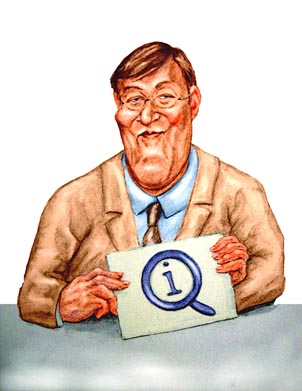
Stephen was Quite Intelligent (and entertaining) from A to M ...
From 2003 to 2016, Stephen Fry hosted one of the best shows on the BBC - or anywhere else for that matter. That is the comedy quiz program Qi. The helm has now been taken over by the Danish-English comedian Sandi Toksvig.
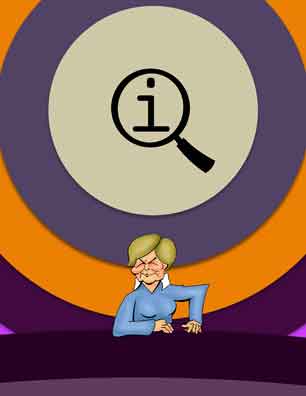
... with Sandi now at the helm.
Although the initials officially stand for Quite Interesting, the reversal of the initials reflects the tone of the show. That is, Qi is directed toward the intelligent viewer who wants to learn rather than those who prefer sitting on their duff, swilling cans of watery beer, while staring glassily eyed at 24/7 sports events or the latest and misnamed reality television shows.
The panelists are mostly drawn from funny people from around the British Isles. The panel's membership rotates but there was a set of early regulars which included Bill Bailey, Rob Bryden (from Wales), Jo Brand (whose weary resignation keeps everyone else sane), and Sandi. Alan Davies who appears on all the shows and is in effect the series' co-star.
Now what strikes the American viewer - or what should strike the American viewer - is the amount of free speech practiced on what is in effect a government run television station. It's not just that in the early shows only one word was ever bleeped out (yes, it's that word). What is really amazing is that many of the topics of discussion and off-hand comments would get an American TV host bounced from the airways quicker than you can say politically incorrect.
Why it is that England, with no US style constitution for the courts to misinterpret, has been able to avoid similar degeneration of freedom of speech and expression is a topic for sociologists and legal historians to contend. But on Qi the credit for the laisse faire brouhaha is simply that Stephen and the other panelists can laugh at themselves as much as at anyone else - something Americans have long forgotten how to do. After all Stephen will joke - and takes good natured ribbing - about his homosexuality, and the various panelists from throughout the UK trade barbs about the various localities from whence they hail. (Question: What do you call a goat tethered to a lamp post in Cardiff? Answer: A leisure center. Question: What do you call a plate of cold chips [i. e., French fries] in Scotland? Answer: A salad. Or in a similar vein: What do you say when ordering a fish dinner in Scotland? Answer: "And chips.")
Of course, nothing is perfect, not even Qi. Some of the information aired is not, alas, correct - or at least it might mislead the unwary. So in keeping with CooperToons' mission to bring enlightenment and education to the world - and in keeping with the spirit of Qi - the following is a list of some of these trifling, trifling errors and ambiguities.
We must admit in Stephen's last season, he didn't get off to a particularly good start, and there were two major errors on the first two shows. One was a bit of Americana. On the first show - "A Medly of Maladies" - Stephen and the panelists mentioned a story about Michael Nesmith - one of the Monkees, the made-for-television rock group that was surprisingly popular during the 1960's. Stephen and the panelists said that Michael's mother was the inventor of Post-It® Notes.
Sadly this isn't true. Michael's mother was the inventor of Liquid Paper® correction fluid. Post-It® Notes were invented at 3M.
What makes this error particularly grievous is that on the "Discoveries" episode - the second show of Series D that was broadcast in 2006 - Stephen actually talked about the Post-It® Notes and how they were invented by a 3M chemist!
Now you may think, well, nine years is a long time for Stephen to remember what the scriptwriters had given him. So we should cut him some slack. But remember, in the very next show Stephen deducted points from Jeremy Clarkson because Jeremy had made an incorrect statement - 11 years before!
It was on this second show that an error was more serious - the more censorious might even call it unforgivable as it involved a bit of British history. Stephen had asked who commanded the Bounty during the famous mutiny. Jeremy remarked it was Captain Bligh. This set off the klaxons and Stephen pointed out that Captain Bligh was a "leftenant", not a captain.
It is true that a number of mistakes seem to concentrate on historical topics regarding Qi's friends from across the sea. For instance on one show we learned that the last words of Pancho Villa (ambushed in Parral, Mexico in 1923) were "Don't let it end like this. Tell them I said something." True, such or similar words have been attributed to the dying Pancho. But the truth is Pancho was hit by nine bullets and died instantly.
In a later episode, Pancho came up again. During the discussion, the then current Dr. Who, Chris Addison, mentioned that Pancho was not Pancho's real name - which is correct. Chris said that Pancho's real name was taken from his grandfather which was Jesus Villa. Alas, Pancho's real name was neither Jesus nor Pancho nor Villa. It was Doroteo Arango Arámbula. In fairness, Stephen did then point out their original "final quote" was in error.
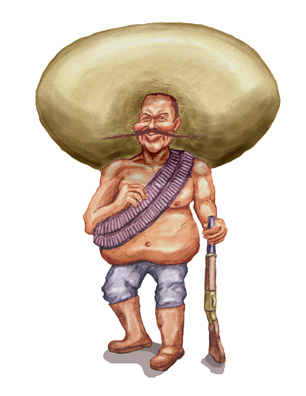
Pancho Villa
(aka Sr. Doroteo Arango Arámbula)
Another American related error occurred during a discussion about Edgar Allan Poe's "Eureka". When Stephen said that the "prose poem" prophesied much of modern science like the theories of the big bang and relativity, he also told how Edgar Allan Poe was an alcoholic who died "literally in a gutter" in Baltimore.
Now it is true that, Edgar wrote "Eureka" and had a severe drinking problem. It's also true that despite many alternative theories to the contrary that the cause of Edgar's death was the effects of delirium tremens, or alcohol withdrawal on October 7, 1848. However, Edgar did not die in a gutter. He was found on a bench outside a local tavern on October 3 and was taken to the Baltimore's Washington College Hospital. He remained there until he died four days later.
There are times, though, that errors seem rather strange. On the Series L Episode "Lumped Together" a rather strange - ah - "mistake" occurred which can't really be called a mistake. This occurred when Stephen began to talk about the famous 1960's hit song, "Louie Louie". This - quote - "mistake" - unquote - is so unique that it merited an essay of its own - which you can read if you just click here.
Of course with Qi's free-for-all format, some of the off-the-cuff tidbits include information that is not quite correct. One discussion led to the topic of American Presidents, and Stephen said that three American Presidents have been assassinated. Stephen missed this by one. There have been four: Abraham Lincoln, James Garfield, William McKinley, and John Kennedy. Attempts were made on the lives of Teddy Roosevelt, Franklin Roosevelt, Harry Truman, Gerald Ford, and Ronald Reagan.
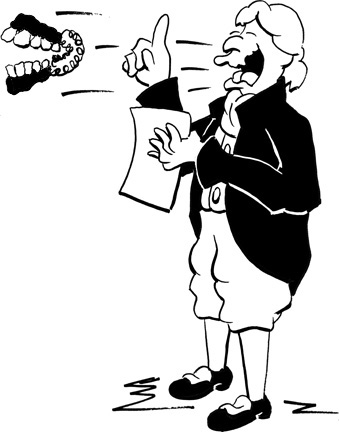
It was George, not Abraham.
Alan also made a mistake about an American president when the question of false teeth came up. He said that Abraham Lincoln had wooden teeth - yes, Abraham Lincoln - and that when he would speak in Congress the springs in the teeth would sometimes make them fly out of his mouth. This is about as wrong as a story can be. First of all, the president with the - quote - "wooden teeth" - unquote - was George Washington and he didn't have wooden teeth. Instead his dentures were fashioned from ivory, hippopotamus, and even human teeth.
As far as Lincoln's choppers go, at the time of his death, the sixteenth president had his natural teeth. True, early dentures did have springs to help keep them in place - we're talking about very early dentures - but as far as we know the Congressional Record has no reference to dentures flying about during debates.
As long as we're talking about American presidents - particularly those with false teeth - this brings up the obvious presidential question which on one show Stephen put to the panel. "Who was the first president of the United States?" he asked. Alan, who regularly falls for Stephen's carefully laid traps, immediately said "George Washington". After the bells, submarine diving-signals, klaxons, and flashing backgrounds signaled the point-deducting and obvious but incorrect answer, Stephen with a show of much regret said George was only the first president an independent United States. The other "presidents", Stephen added, were the presidents of the Continental Congress.
Actually Washington was the first president under the current US Constitution, and there were, as Stephen said, previous presidents of the United States. But it isn't correct to say these were just Presidents of the Continental Congress. The first president of that august body was Peyton Randolph who assumed the chair on September 5, 1774. At that point the Congress was not interested in declaring independence but just in airing some gripes about the way Mother England was treating her children. The Second Continental Congress convened May 10, 1775, again with Peyton as President, and that was the Congress that declared independence.

Alan Davies
Falling into Stephen's Traps
But the first president of a truly independent United States was the president elected following the adoption of the Articles of Confederation - or more completely The Articles of Confederation and Perpetual Union. The Articles - the first "constitution" of the United States - were adopted on November 15, 1777. From that date followed ten presidents of the Confederation starting with Samuel Huntington.
On the other hand England did not recognize the Articles as valid, and so the first president to serve under a completely and indisputably independent United States was Richard Henry Lee who stepped to the podium in 1784 after the ratification of the Treaty of Paris. There were four more presidents of the Confederation (one of which was our friend with the big signature, John Hancock), and the last was Cyrus Griffin. After Cyrus, the current US Constitution went into effect, and George Washington was sworn in April 30, 1789.
The title, by the way, - the Articles of Confederation and Perpetual Union - does show that the intent of the Founding Fathers was one of a non-dissolvable union and hence provided no criteria for the states seceding from the Union. Since the current constitution created a stronger federal government it seemed pointless to state what was obvious to the country's founders. But the doctrine of secession began almost at once (actually in New England of all places) and has continued to the present day with various groups who think if everyone won't play by their rules, they'll take their ball and go home. Unfortunately, they already are home.
Stephen usually closes each show with another quite interesting tidbit, and once he related how DNA tests had demonstrated that Thomas Jefferson fathered the children of his slave, Sally Hemings. This has been, in fact, a common belief ever since the DNA findings were announced in 1998. But strictly speaking the tests proved no such thing. What the tests showed was that some of Sally Hemings' descendants shared common ancestry in Tom's family. In particular Eston Hemings, Sally's youngest son, had a Y chromosome derived from the Jefferson lineage.
Now some people say, well, it must have been Tom since Sally was his slave, and she went to France with Tom when he was appointed minister to France. On the other hand, Tom's defenders get rather huffy about the insinuation that Tom - a man of character and honor, we hear - would take advantage of a young defenseless woman. An alternative explanation, they say, is simply that Sally's children were fathered by another male Jefferson. Tom's uncle is one possibility and his brother, Randolph is another. Of course, that the story originated as a smear campaign by Tom's political enemies also has to be taken into account.
On the other hand, no one should really take the stand that because Tom denied it, his family denied it, and Tom had high "character" as proof the story is untrue. Why should we believe Tom's denials any more than those of today's men of - quote - "character" unquote - like some of our modern politicians and religious leaders? After all, Tom was a male with a fully functioning set of hormone producing glands, and he never married after the death of his wife, Martha. At the time he was only 39. The fact that Tom freed all of Sally's children and none of the other families of slaves en masse shows that there was something special in Tom's mind about Sally and her brood. In fairness to Stephen, we have to admit the tendency of historians who have studied the totality of the evidence is to accept Tom's as the father of at least some of Sally's children. But the DNA evidence itself did not and cannot conclusively prove Tom's paternity.
More problematical is the type of information that is true, but only fortuitously, not to say accidentally so. For instance, Stephen said that the 600,000 Americans at the Battle of the Bulge in World War II was "more than the whole of the Battle of Gettysburg". Of course, this is correct. But the actual troop numbers at Gettysburg were far lower, about 90,000 Union and 70,000 Confederates - 160,000 men maximum. Certainly 600,000 is more than that. The error here is a confusion with the military strength at Gettysburg with the total number of soldiers who died in the American Civil War altogether. The latter number is indeed close to 600,000 (actually it's more) of which around 200,000 died in combat.
Of course, like all of us Stephen likes to tell a good story for its own sake and will point out that the story is sadly not true. Once he asked the panel what were the last words of Admiral Horatio Nelson's, and Alan gave the expected answer "Kiss me (or kismet), Hardy". Alas, that was flagged as incorrect as were Nelson's "official" last words, "Every man must do his duty." The answer, Stephen said - that is, Nelson's real last words - were "Drink, drink, fan, fan, rub, rub." This story is supported by modern scholarship.
But before he told of Nelson's real last words, Stephen had told the tale of how after Nelson died, he was put in a cask of brandy. Then, so the story goes, the sailors would sneak up and take a swig through holes in the barrels using macaroni straws. This led to the expression of "tapping the admiral" when sailors take a surreptitious snort. By the time the ship got back home to England, we learned, the brandy was gone.
Stephen closed by saying that the story was apparently not true. Not only did Nelson's biographer point out the cask was strapped to the mainmast and kept under guard, but the idea that sailors would knowingly sip the sauce of a pickled corpse is absurd. Stories of people eating what they thought was food only to find it was a medium used to preserve a corpse are also among the oldest of folk-tales. Besides, why would sailors creep on board and sneak sips of brandy when they could also have slipped below and snuck sips of the rum that was at that time a staple of shipboard cuisine? It's a funny story (sort of), but a bogus story.
One time that Stephen "misspoke" about English history was concerning the haemophilia that ran through Queen Victoria's family. Before her time, Stephen pointed, there were no cases of the disease in the royal family. "So either," he said, "one of her parents had a 1-in-50,000 gene mutation, or she was the illegitimate daughter of a haemophiliac."
However, medical resources (and not the Fount of All Knowledge) report that cases of haemophilia showing up in families with no documented history of the disease are fairly common. In fact, recent, research has shown that about 30% of haemophilia occurs spontaneoulsy.
Medicine is indeed a complex subject and we can forgive an occasional mistake. On one of the shows the screen displayed an electrocardiogram trace which suddenly went flat. What, Stephen asked, did that mean.
Alan (of course) said it meant the patient was dead. And of course that kicked off the klaxons and Stephen sadly told Alan that the EKG going flat was a dramatic device created by television and the movies and in a real hospital it would simply mean the electrical cord became disconnected.
Well, we remember that Stephen studied literature at Cambridge, not medicine. But the first thing that a doctor, anesthetist, or nurse would do seeing an EKG go "flatline" - as they call it - is assume that the patient's heart had stopped and begin resuscitation procedures. For what it's worth and despite what you may see on television and in the movies, if a patient's heart does stop there's perhaps a 10 % chance the resuscitation will be successful and even a smaller percentage of those patients will leave the hospital hale and well.
As far as what happens if the cord is pulled out of a EKG monitor, you get the same thing if any electrical instrument is disconnected. The whole instrument would shut down and any display would simply go off.
In matters of Stephen's own specialty, English literature, Stephen made what is admittedly a minor error, but an error nonetheless. When discussing the James Bond novels of Ian Fleming, Stephen mentioned that "For instance, Bond has his strange ideas. He has this idea that homosexuals cannot whistle, for example". Naturally Stephen immediately whistled. That got a laugh.
Actually in the books the idea that "homosexuals cannot whistle" was not something any character necessarily believed. In one of the early chapters of The Man with the Golden Gun, Bond's superior, M. (i. e., Admiral Sir Miles Messervy), was reading the dossier of the American-Cuban assassin, Francisco "Pistols" Scaramanga. In the "Motivation" section written by a former Oxford Regius Professor known as "C. C", M. read that Scaramanga could not whistle. CC - that is, CC - added the comment, "Now it may only be a myth, and it is certainly not medical science, but there is a popular theory that a man who cannot whistle has homosexual tendencies." M. who hadn't whistled since he was a boy, "unconsciously pursed his lips and a clear note was emitted". In any case, in the books there is nothing that says James Bond believed homosexuals could not whistle.
Another minor faux paux in English literature was in the "Green" show where Danny Baker, Bill Bailey, and Jeremy Clarkson were the guests. The topic of Mary Shelley's novel Frankenstein came up and Stephen put up the question of what was the monster's skin color. Danny's answer of "Green" set off the klaxon's and bells. Frankenstein of course was the doctor's name, not the monster's so he had regular flesh colored skin. Stephen then asked what color was the monster's name. Bill Bailey's answer of "Green" (immediately emended to "purple") also set of the klaxons, and Stephen told everyone that the real answer was "yellow".
But during the discussion, Danny asked if anyone knew that the - quote - "monster" - unquote - did indeed have a name. Everyone was interested and Danny said the name was "Adam." Everyone was impressed with Danny's knowledge.
Sad to say, impressive as it is to know that the Frankenstein monster was named "Adam", this is not quite correct. The confusion comes from the fact that the monster - who could speak - did tell his creator, Dr. Victor Frankenstein, that he "ought to be thy Adam, but I am rather the fallen angel." True, there are references on the Fount of All Knowledge that Mary Shelley referred to the creature as "Adam", but the references are given metaphorically. In the text of the novel the monster has no specific name.
You will also notice that Stephen phrases his questions carefully to make people fall into his traps. Jeremy is known for his quite outspoken views and when Stephen asked "According to the Vegetarian Society, why are people who don't eat meat called vegetarians?", Jeremy responded "So we can identify them as fools and madmen." After a camera cut to Alan (who is a vegetarian) and the usual banter, Jeremy then responded "Well, presumably it's the word 'vegetable'."
This set off the klaxons and bells, leading Stephen to say "That's not why they are called vegetarians". He added "The surprising point perhaps to most people is that the original word from which the word 'vegetarian' comes, in the opinion of the Vegetarian Society, is not the word 'vegetable', that's the point. It has nothing to do with vegetable ... It is the word 'vegetus' which has nothing to do with vegetation oddly enough. It is a Latin word meaning 'whole, sound, fresh, or lively'."
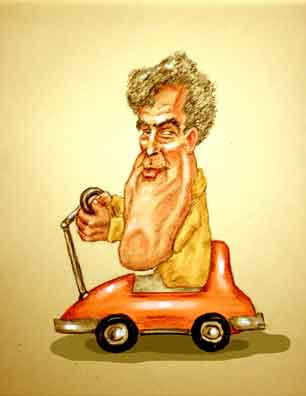
Jeremy Clarkson
Quite Outspoken
Strictly speaking, Stephen is not quite playing fair. The question was phrased in terms of the definition "according to the Vegetarian Society". Indeed the Society may indeed claim "vegetarian" is derived from "vegetus", but unfortunately that claim does not make the claim true. In fact, the Oxford English Dictionary cites the word as indeed arising from 'vegetable' with the first appearance in 1839. So at best the origin of the word is not clear, and it doesn't seem quite fair for Stephen to have deducted points when Jeremy gave an answer that is accepted by the majority of linguists.
Mathematics can also be quite interesting, and in the third season Stephen posed a question which led to his relating how Florence Nightingale invented the pie chart. Once more this is not true. Yes, Florence was a mathematical savvy lady who used a pie chart to illustrate the causes of death in the army. But the invention of the pie chart is credited to William Playfair, a pioneering statistician who had first used a pie chart to show the division of the Ottoman Empire by continent. That was in 1801, and when William died in 1823, Florence was only three years old.
This error also brings us to the point of the sources used by Qi's researchers, the Qi Elves as they're called. What is Quite Interesting (note capitalization) is that this very mistake was one you can find in a Ripley's Believe It Or Not column which actually appeared before the Qi broadcast. In addition to the tidbit (or "titbit" as the British say) about Florence and the piechart, there are other topics appearing in Believe It Or Not before their mention on Qi. Some of these overlaps are:
- Tastebuds of catfish are distributed over their entire body.
- Jello produces the same electroencephalogram as a living human brain.
- The Parthenon in Athens has no straight lines.
- There are 806 million billion billion billion billion billion billion arrangements of playing cards (actually 80,658,175,170,943,878,571,660,636,856,403,766,975,289,505,440,883,277,824,000,000,000,000 arrangements).
- A Japanese company has created a robot that can walk downstairs.
- The American Pony Express advertized for "Young, skinny, wiry fellows, willing to risk death daily. Orphans preferred."
- Big Ben is neither the famous clock in London or the clock tower. It is the bell.
- The Sahara Desert has more precipitation than Antarctica.
- St. Patrick was not Irish.
- Robert Burns did not write the lyrics of Auld Lang Syne.
- George Washington was not the first President of the United States.
Although we realize that the similarities could simply be that the Qi researchers and Robert used the same sources, the number of coincidental items gives one pause. So we must wonder if when deadlines threaten, the BBC's top-notch Oxbridge researchers needs must have them dipping into the writings initiated by an  high school drop out.
high school drop out.
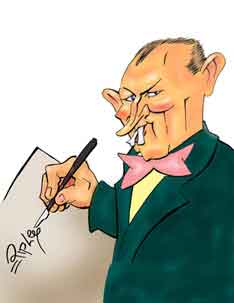
Robert Ripley
A Qi Source?
Not all, errors, of course, are from what is actually said. In refuting the story that Julius Caesar was born by Caesarian section (in Roman times no mother survived C-section surgery and Caesar's mother lived well into his adulthood), a photograph of a Roman emperor was displayed on the background screen. But today's historians do not include Julius in the list of Roman emperors. He was granted the title of dictator perpetuo or "dictator in perpetuity" but not that of the hereditary imperator. But the statue in the photograph wasn't Julius. It was his grandnephew, Octavian, later Caesar Augustus, who was the first emperor of Rome .
By the way, the inadvertent - or at least misleading - errors of the displayed images haven't been limited to that of Augustus or Julius Caesar. When the question was "What ape walks upright (other than man)?" the audience saw pictures of a gorilla, an orangutan, a chimpanzee, and a baboon. Baboons, though, are monkeys, not apes. (The correct answer, for those who are interested, was a gibbon.)
Another error regarding Roman history, though, could have been made into a great question. When talking about Nero, Stephen mentioned that his last words were "What an artist dies in me!" (or in the Latin "Qualis artifex pereo!"). True, Roman historians attributed these words to Nero, although there is an alternative translation proposed by Professor Ted Champlin of Princeton University. Rather than lamenting that the world is loosing a great artist, Professor Champlin suggests Nero was really saying "What an artisan I have been reduced to in my dying!" In other words, Nero is lamenting his own sad fall from the august position of emperor.
But whatever the correct translation, "Qualis artifex pereo!" were not Nero's last words at all. As he lay dying after stabbing himself in the throat, a soldier walked into the room. Striding to his emperor's side, the man held his cloak to the wound. Nero looked up and said his true last words, "Too late! This is loyalty."
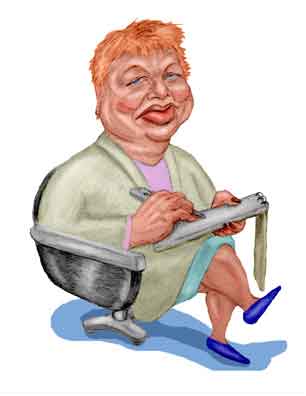
Jo Brand
Keeping the rest sane.
So we see that though historical questions are always quite interesting, the answers are not always quite correct. In yet another discussion on Roman history, Stephen stated that gladiators were not killed on the signal of thumbs down from the emperor as is so often shown in movies and paintings. Instead, he said, the signal was actually thumbs up.
Now you can hear similar "corrections" to the popular image of the thumb pointing emperor on various educational and history shows. But there is disagreement on what the correct signal was. Some talking heads have said the emperor actually pointed his hand palm down to spare the defeated swordsman and pointed his thumb toward his neck to signal "Ugula!" ("Kill him!")
Alas, there is really no point in discussing the matter at all. Once more the sad truth is the actual signal isn't known. The Latin term for the gesture was simply pollice verso - literally "with turned thumb". No one knows if it was up, down, sideways, or pointed anywhere else.
Staying in Italy, but moving a bit forward to the Renaissance, Stephen once pointed out that the drapery painted behind God on the Sistine Chapel panel of Michelangelo's Creation of Man is believed by some doctors to represent a cross section of the brain. "What it argues," Stephen said, "is that he [Michelangelo] was present at some dissections which were very popular, but completely illegal in Italy at this time."
"It seems," Stephen added, "that Michelangelo may have been lying about his illegal dissecting activities, though why he would risk painting a huge piece of incriminating evidence on the ceiling of the Pope's chapel is anybody's guess."
Very likely Michelangelo did nothing of the sort. That some doctors think Michelangelo was painting the shape of the brain does not rule out the strong possibility that the shape was purely coincidental. Seeing shapes and forms in paintings (or in clouds or photographs or tea leaves or on pieces of toast) is often due to the human tendency to try to make sense out of random images. Of course, we can't tell what was in Michelangelo's mind when creating a specific pattern, but that some brain specialists see the brain in a work of art may mean absolutely nothing about what was in the mind of the artist.
On the other hand Stephen did make quite the factual faux pas in the discussion. The error which will immediately be recognized by students of the history of both art and medicine.
One of the biggest myths of our modern era - rivaling the myth that everyone thought the world was flat until Columbus made his voyages - is that dissection was illegal and banned in the Middle Ages and the Renaissance. Not true at all. Autopsies were carried out openly and above board and are documented in Italy as early as 1286. They were no more more forbidden than the normal embalming processes which at that time was simply gutting the body to slow down decay.
In fact, one of the earliest purposes for dissection will raise some eyebrows particularly with those who think the "Church" was opposed to hacking up the human body. If an abbot or abbess of a monastery or convent died and was a good candidate for sainthood, the monks or nuns might rummage around in the deceased's viscera to find some indication that the deceased was a saint. If something quite interesting was found, like an organ with folds that looked like a cross or a kidney stone that looked like the crown of thorns, the congregation would vouch for the "evidence" at the canonization hearings. In one such case, the Pope's criticism was not for the chopping up of the an abbess, but his doubt that the nuns really found what they said they did.
We also have records that dissections for teaching, research, and forensic information were carried out well before 1400, once more without any censure or legal prohibitions. In fact, dissections became an extremely popular - and public - form of entertainment. Crowds of up to 500 people would show up at advertised dissections, and temporary bleachers had to be erected. Large buildings - including churches - were used to house the audience.
You will also read or hear that because of the theological doctrine of resurrection of the body, the Church only officially approved of dissecting executed criminals (both male and female). Aside from the fact that the Church made no such ruling, there was the practical problem that the supply of criminals was quite limited. Executions in the Renaissance were far fewer than commonly believed. Florence, for instance, had perhaps 6 executions per year. The American "Hanging Judge" Isaac Parker, executed that many in one day on July 1, 1896.
Instead, a far more ready source of cadavers were hospitals where deaths were frequent and a number of the subjects were poor and without family. Once Leonardo Da Vinci was visiting the hospital of Saint Maria Nuova in Florence (still operating - no joke intended - today), and noticed an elderly patient. Leonardo sat down to talk.
Leonardo passed a pleasant time with the old gentleman. The man, who was over a hundred years old, replied there was no pain, just a general weakness. In a few hours the man died and immediately Leonardo had the man taken to the mortuary and cut him up - to find the cause of so sweet a death, he wrote, and in doing gave us our first accurate description of arteriosclerosis
So did Michelangelo perform dissections? Many art historians think he did, although Michelangelo left no documentation as did Leonardo. Even if he did not do the dissections himself, Michelangelo's facile draftsmanship would have been a major asset even if he studied anatomy simply by attending public dissections. We know as a young man he spent three months in Bologna where even to this day the university has a medical school of international reputation.
Probably what confuses a lot of people into believing dissections were banned was what happened when Leonardo was living in Rome. He was not doing much painting at that point but living off the patronage of Guiliano de Medici. Instead he was carrying out scientific experiments, which included studies of anatomy. Suddenly the Pope ordered Leonardo to cease his anatomical studies. Most people think this meant that the Pope was simply enforcing the church policy against dissection.
But the Pope did not ban dissection per se. Instead his order was directed specifically at Leonardo. Evidently Leonardo had been having a professional dispute with a craftsman he had hired to help him prepare mirrors possibly for work on building a solar furnace. The worker (called Giovanni although he was German) evidently spread some kind of rumors to the Pope and at the hospital where Leonardo was conducting his dissections. Some speculate the workman had said Leonardo was practicing sorcery. But a more recent historian thinks that Leonardo's studies led him to believe that an unborn fetus had no soul and so no separate identity before birth. Even at that time, such a belief was against Catholic doctrine, and the most expedient way for the Pope to quash any rumors, whether of sorcery or heresy, was to tell Leonardo to cut it out (once more, no joke intended).
Enough about Leonardo, although he was, we acknowledge, quite interesting.
Moving on, but sticking with the topic of the papacy, in Season 1, author, television presenter, and former conservative member of Parliament, Gyles Brandreth, mentioned part of the ceremony of the crowning of a new pope. Gyles stated that to assure themselves the newly elected Pope was not a lady who snuck in the College of Cardinals, the Pope would sit in a special sedan chair and be carried aloft, exposed in all his glory. The cardinals would look up and say, "Testiculos habet, et bene pendentes!" This, of course, means "He has two testicles, and they are hanging well!" The ceremony began, we learn, because one of the early Popes - Pope John VII - was actually Pope Joan, a woman.
Today, Gyles, added, the Pope does not display himself. But, he added, the lifting aloft of the pope is still part of the ceremony upon the coronation of a new pope.
This story is a very popular one on the Fount of All Knowledge (i. e., the Internet) and was given a shot in the arm by a scene in the television show The Borgias where Roderio is elected Pope. The story, though, has been debunked in authoritative accounts reported in those non-electronic devices with white flappy things in the middle. In a book by a well-known authority on biology, it was pointed out that the basis of the story - that there really was a Pope John who was really Pope Joan - is now discounted as fiction, and there are also discrepancies in the reports of the actual ritual - a warning sign for a fabrication. In addition to Gyles' version where the Pope is hefted high, in an alternate version the cardinals just file past and take a quick peek at the Papal testiculos. In another - depicted in the Borgias - a designated cardinal actually reaches under the chair and satisfies himself the new Pope has all the required accouterments. Again all this stuff about the viewing of a new Pope's genitalia may be a quite interesting story, but it is, alas, quite untrue.
Keeping in the same time frame was another question Stephen put to the panel: "Who was the first man to sail around the globe?" Of course, the answer given by Alan was "Magellan". Instantly, the klaxons went off, and Stephen pointed out that Magellan had been killed in the Philippines before his voyage was over, and so didn't complete the voyage. It was the (few) survivors of his crew, including Sebastian de Cano, who were actually the first men to sail around the world.
There is a bit of controversy about that. There is one account that - strictly speaking - Magellan was the first - and before everyone else on his voyage. The story is that in 1505, Magellan - aged 25 - had sailed on a voyage to India. Naturally they went east around the Cape of Good Hope on the tip of Africa following the route of Vasco da Gama in 1497. On his 1505 voyage Ferdinand actually went as far east as the Mollaca Islands which is east of the Phillipines island of Mactan where he was killed 16 years later. But after Ferdinand left the Moluccas, he naturally sailed west back home to Portugal. Then in 1519 he sailed on his famous world cruise and of course went west around South America, crossed the Pacific, and passed the longitude he had crossed in his earlier voyage. So although it took him about sixteen years, he really had completed a circumnavigation of the globe in 1521 while the remaining crew didn't get back home until 1522.
Is this story true? Alas, most historians discount it as a latter day fabrication to make the Ferdinand-was-the-first story true. So at least for now we have to stick with Stephen's answer.
Stephen sometimes will pose what must be called trick questions, which even if answered - quote "correctly" - unquote - is not really answered correctly. That is because - in legalese - the question assumes facts not previously established, or more accurately, assumes fact that are not correct. Once Stephen asked the panel "Which comedian went and dropped an atomic bomb on Japan?" The "correct" answer we learned was "Zeppo Marx". But then Stephen explained that Zeppo left the Marx Brothers and set up an engineering firm which designed the clamp that held the bomb in the bay. So with regard to the original question, Zeppo did not "go and drop an atomic bomb on Japan" or anywhere else.
During the course of the show, there is much and at times almost incomprehensible banter (at least to the American ear) between Stephen and the panelists. So it's not surprising that in the course of the the back and forth repartée that errors slip in. At one time Alan Davies wondered why a common word for cat also means "front bottom" (ergo, "pussy" for those who have to have it spelled out). Stephen replied the word came is derived from "pasht" the ancient Egyptian word for cat.
Actually the Ancient Egyptian word for cat, 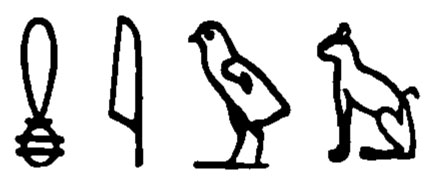 , is transliterated by Egyptologists as "miw" and was certainly pronounced something like "mee-yew." Such onomatopoetic words aren't unusual in the ancient Egyptian language. Donkey, for instance, was "ah-ah" (
, is transliterated by Egyptologists as "miw" and was certainly pronounced something like "mee-yew." Such onomatopoetic words aren't unusual in the ancient Egyptian language. Donkey, for instance, was "ah-ah" (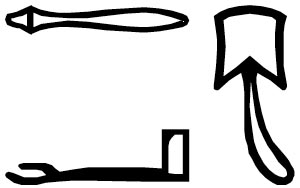 ), the Egyptain rendering of "hee-haw", and wine - which even then caused the imbiber the occasional hiccup - is "erp" (
), the Egyptain rendering of "hee-haw", and wine - which even then caused the imbiber the occasional hiccup - is "erp" (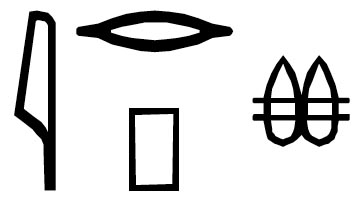 ). (As an aside, the word "fanny" which is a vulgar term for "front bottom" in Britain - is a quite mild term for "back bottom" - ergo, "rear end" - in America. So an American should never ask an Englishwoman if she has ever fallen on her fanny.)
). (As an aside, the word "fanny" which is a vulgar term for "front bottom" in Britain - is a quite mild term for "back bottom" - ergo, "rear end" - in America. So an American should never ask an Englishwoman if she has ever fallen on her fanny.)
Of course, as in many debates about what is absolutely true and unquestionably false, much of the veracity of Qi depends on how you define your terms. For instance, Stephen brought up a point about the English inventor and photographer, Eadweard Muybridge, the father of the motion picture (Eadweard is his name, not a misprint). Stephen said Eadweard was the first person to use the insanity defense in American legal history. Steven went on to add that as a young man Eadweard murdered his love rival in cold blood.
Now "love rival" is perhaps too mild a term for the gentleman in question, a Major Harry Larkyns, as the major had been paying undue attention to Flora, Eadweard's young wife - so much attention that Flora's newborn baby was probably Harry's, not Eadweard's. So Eadweard showed up one day at the Larkyn residence, pulled out a gun, and shot the Major dead. His lawyer argued a case of insanity as his client had received a head injury some years before.
Once more we must point out that claims of insanity have always been recognized as a valid plea in American courts just like in early English common law. But Eadweard's plea was certainly not the first plea of at least some kind of insanity in an American court.
Eadweard's trial was in 1874 when he was forty-four. But almost a quarter of a century earlier, in 1850, New York's Congressman (and later Civil War General) Daniel Sickles shot and killed his wife's paramour after he discovered some hanky panky was going on. Daniel - or rather his attorney - argued the case of temporary insanity.
So we pose the question. Are we to accept that a specialized version of an accepted legal defense was used twenty four years before the first general application? That seems unlikely. In any case, Daniel was acquitted
As far as Eadweard's insanity plea, it didn't matter. In addition to saying his client was crazy, Eadweard's lawyer had argued that by killing his wife's boyfriend, Eadweard was simply following the "higher law" law of the Bible which says an adulterer must surely be put to death. So if the California law didn't permit capital punishment for a man who was bowing another man's fiddle, the owner of the violin could shoot whoever was stroking the strings. This was certainly a quite interesting defense - that a man was insane for obeying the Bible. Ultimately, Eadweard's arguments - whatever they were - carried the day, and he was set free. Manly honor was a big thing in the nineteenth century American West.
There are also some answers that can be thought of as correct in substance, but not in detail. Stephen once related how in 1995 NASA did studies on spiders who had been given lysergic acid diethylamide, that is the "hippie" drug, LSD. The spiders on the drug, we learn, spun more perfect webs than they did in nature. Caffeine, on the other hand, made the spiders create irregular webs. Photographs of the webs were displayed on the background screens.
Perhaps Stephen simply misspoke by 30 years. But the effects of drugs on spiders, including LSD, were already published by the end of the the 1960's. You can even see the photos of the webs spun by spiders under the influence in the Time-Life series of books that were printed decades before 1995.
In another science question, Stephen asked "How many moons does the Earth have?" "The Earth has one moon," Alan responded, "which is made of cheese." That - the answer "one" - once more set off the bells, diving signals, and flashing backgrounds. Sadly Stephen said, there were two. There is the Moon, as we call it, and another smaller moon called Cruithne.
There was quite a bit of skepticism from the panel. "But it does have one," said Alan. "It's called 'the Moon'." "'Blue Moon'," said another panelist Jeremy Hardy. "'I saw you standing alone'. Not 'with a small friend.'" American Rich Hall wondered "So why is there not one romantic song with the word 'Cruithne' in it? 'Blue Cruithne of Kentucky' or 'Cruithne River'?" "Because," Stephen replied with some exasperation, "It was discovered in nineteen-ninety [bleep]ing four!" Nine years, said Rich (the show was aired in 2003), was plenty of time to write a song.
However, Alan and the others had justification for their complaints. First, Cruithne - pronounced "Croo-ee-nyuh" in its proper Gaelic - was discovered in nineteen-eighty [bleep]ing six. Next it isn't really bound gravitationally to the earth. In fact at some times it is quite a ways from the earth. So it's not a true moon.
Instead, Cruithne is an asteroid circling the Sun. But because it has a periodicity of 364 days - one day shorter than the earth's and it crosses the path of the Earth, its orbit is in "resonance" with the Earth's. Its orbital incline is also significantly out of the plane of the solar system. Such peculiarities give Cruithne a curious kidney shaped path in relationship to the Earth, and this can make it look as though its orbit is more influenced by the earth than it really is. On the other hand, Cruithne's orbit is unstable and it does pass close (in astronomical terms) to the Earth. So perhaps in about 5000 years it may go into a true orbit around the earth. It would be a moon then. But it isn't now.
Warnings must also be given in cases where the story may be true at one level but is questionable regarding the totality of the information conveyed. Rob Bryden told the story of Alec Guinness predicting the death of James Dean. Alec said that after he saw James' new sports car, he told James that if he got into the car he would be dead in two weeks. Sure enough, in two weeks, we learn, James had his fatal car crash.
That Alec told the story may be true enough but the complete accuracy of all details must remain a bit questionable. Prophecies or other stories of prescience should only be accepted if 1) the prediction can be reliably documented to have been made BEFORE the event occurred, 2) the actual event is also documented in detail by impartial witnesses, and 3) the prediction is sufficiently specific that the following event is clearly something other than a coincidence, a good guess, a low probability occurrence, or a misinterpreted natural phenomenon. Few if any - quote - "prophecies" - unquote - ever meet those criteria. Alec's tale does not.
Some errors admittedly might be more a matter of differences of interpretation than being an actual faux pas. Stephen mentioned that the Swiss chemist Albert Hofmann "rediscovered magic mushrooms". It is correct that Albert was the research director of the company that isolated the active ingredient of psilocybin mushrooms. However, anthropologists, ethnologists, and interested laymen had always known that the Native Americans had used (and still use) the peyote mushroom as part of their religious rituals. The mushrooms themselves never had to be rediscovered.
A more definite error was a comment by comedian Bill Bailey. He said that the CIA funded Albert and so ironically it was the CIA who was ultimately responsible for the discovery of LSD and so the whole psychedelic movement. The CIA funded Albert, we learned, because the CIA "got wind of" Albert's experiments.
Diligent research has found no indication the CIA funded Albert's research into LSD. In fact, it would have been impossible. His research on lysergic acid derivatives was being published as early as 1937, and he discovered LSD-25, that is, lysergic acid, diethylamide, in 1938. Albert's deliberate self-experimentation on the drug's effects was in 1943. Even that late date was 4 years before the CIA was founded.
As far as his funding, Albert's support came through normal research channels of his company, and he reported his findings in the peer reviewed scientific and patent literature. Nothing he did was secret or classified.
One particular area where errors can creep in is regarding science, particularly science discussed in a quantitative sense. For instance Stephen said physicist Ray Davis proved the existence of neutrinos by going into a mine 50,000 feet below the ground in Leadville, Colorado. This was probably just a because 50,000 feet is over 8 miles down. The deepest mine penetrates only about 2 miles. So even if the mine Dr. Davis used was 2 miles below sea level and adding the 14,000 feet of Leadville's elevation, that would not even be five miles below the local surface of the earth, much less eight.
Science errors can also easily arise from off-hand comments. For instance in the episode on hoaxes, Stephen spoke about how Stephen Jay Gould, the famous biologist, concluded after a lifetime of study that there were no such things as fish. What Stephen Jay meant was that fish, regardless of how similar they look, had diverged in the evolutionary line so early that some are more related to humans than they are to each other. But Stephen (Fry) said in passing was that Stephen Jay had won the Nobel Prize. Alas, Stephen Jay won a number of awards and prizes, but never the Nobel. There is, in fact, no Nobel Prize in biology per se although biologists have sometimes been given an award in the fields of Physiology and Medicine or Chemistry.
On one episode the subject of "ordeal by bean" came up. A crack about Mr. Bean got 10 points deducted, but in the course of the following discussion, Arthur Smith said 95 % of the baked beans in the world are eaten in Britain. No one else eats baked beans, he said, aside from the Finns.
Now that comment is sure to make Americans scratch their beans, particularly since Arthur's comments were almost immediately contradicted and yet no one on the panel seemed to realize it. Alan started talking about Heinz baked beans and asked why can't everyone make beans like Heinz. So, we ask, does Heinz make baked beans only in England? Or do they prepare the beans in America and ship 95% to the UK and the rest to Finland? Not, as Eliza Doolittle said, bloody likely.
The truth is you can walk into any supermarket in the US and see rows of cans labeled "Baked Beans". Baked beans have long been a major staple in the United States. Boston's baked beans are a famous local cuisine and are quite tasty.
American food has also caused other errors to slip in. On the episode where ventriloquist Nina Conti appears with Gran, Stephen spoke about Edward Bernays, a nephew of Sigmund Freud, who "invented" the breakfast staple bacon and eggs. Edward, said Stephen, "invented" the dish as part of an advertising campaign. "The American breakfast", Stephen said, "was very light." Edward, he added, convinced Americans they should eat "heartily". Edward also got women to smoke. "Women", Stephen added, "just didn't smoke" and added in New York City a woman was arrested for smoking outside. Edward, Stephen said, invented public relations.
As admirable and interesting as this discussion was, the majority of the sentiments are not true. Part of the problem is that the statements assume a uniformity in culture, tastes, and cuisine - particularly in America - that is simply not correct. True, it is difficult to find references to making bacon and eggs in old cookbooks, which inevitably focused on "fancy" dishes or at least dishes that were more involved and had multiple steps. On the other hand, bacon and eggs and its close cousin, ham and eggs, can be found as breakfast staples well before Edward Bernays. Mark Twain makes reference to bacon and eggs, and indeed, like many westerners, he ate "heartily" for breakfast. Even in England, ham and eggs were popular - as any true fan of Sherlock Holmes knows from the reading of the second Holmes novel the Sign of Four. Sherlock and Dr. Watson seemed to eat what seem to be very Americanized breakfasts.
As for as women not smoking before the 1920's - which is the timeline of the "Torches of Freedom" story - this is definitely not true. In fact, women smoked cigarettes as early as the 19th century. There is even a photograph of some of the women students and assistants of the famous sculptor Auguste Rodin taking a smoke break in the studio.
In the episode called "Greats" Stephen also seemed to confuse taste with smell. At one time it was taught in elementary schools (and also in the great television show "Mr. Wizard"), that what most people think of as taste is really smell. Taste in humans is mainly limited to salt, sweet, sour, and bitter, although today the "umami" taste of monosodium glutamate is often (as Stephen did point out) sometimes added. But in this show, Stephen mentioned that grated Parmesan cheese tastes more intense because of it's greater surface area comes into contact with the tongue. That isn't correct because the taste of Parmesan cheese is in fact its smell. The greater surface area is important, yes, but that is because there is released a greater number of the odor molecules - which Stephen pointed out are indeed low chain fatty acids - and so the concentration at the olfactory receptors is greater.
Some bits of knowledge could also be expanded. When talking about game theory, Stephen correctly said the field was invented by John Von Neumann and Oskar Morgenstern. He then went on to say it was more fully developed by John Nash, who after some discussion, the panel identified as the subject of the movie A Beautiful Mind starring Russell Crowe.
True, John Nash won the Sveriges Riksbank Prize in Economic Sciences in Memory of Alfred Nobel (which strictly speaking is not the same as a Nobel Prize) for his work on game theory. John Nash proved that every two person game has what we now call the Nash Equilibrium where no player can improve his outcome regardless of what the other does.
It has become fashionable to downplay game theory as looking fine on paper, but falling flat in practice. After all, when the RAND corporation tested the theory, the participants - ergo, real people - actually avoided Nash's equilibrium points in their behavior. On the other hand, we need to remember, though, that game theory is a method to determine rational choices. It is a computational tool and makes no claim that human beings will take the rational path.
Another debatable issue was the cause of death of the Irish playwright, Brendan Behan. Stephen said Brendan Behan died of severe cirrhosis of the liver. Now Brendan may have had cirrhosis of the liver, and this may have hastened his early demise. But virtually all sources say the primary cause of Brendan's death at 41 was his diabetes aggravated by his refusal to stop drinking.
Errors - or at least debatable issues - also arise when the panelist relate their knowledge which isn't checked by the Qi elves. Panelist Jan Ravens said that the first impression in history was the portrayal of Socrates in Aristophanes' play The Clouds. Now this could be true since Socrates was a character in the play, and the real Socrates was alive when the play was first performed. It may also be true that this was the first time a living public figure was lampooned in a comedy. But then Jan went on to say the play was the reason Socrates was put on trial.
It is certainly the case that the portrayal of Socrates in The Clouds is unflattering in the extreme, and it shows the Athenians did not consider the philosopher simply as a harmless nut. The ending of the play - where Socrates is burned out of his academy (called the "Thinkery") and stumbles out blinded by smoke and groping helplessly - reflects a true hostility toward the man and his students. Some of the statements put in the character's mouth are also near verbatim to some of the charges listed in Plato's Apology. And according to both Plato and Xenophon the Athenians accused Socrates of impiety and corrupting the youth.
Instead half a century after Socrates was dead, an Athenian statesman stated flat out that Socrates was brought to trial specifically because he taught Critias, an opinion shared by many modern historians. Critias as one of "The Thirty", among other things, led a reign of terror where 1500 citizens were summarily executed. We don't hear anything about Socrates being impious, teaching rhetoric, or studying science. Since the teachings of Socrates as related in Plato's writings were decidedly anti-democratic, it's not that far off to say that Socrates' philosophy did indeed "corrupt" Critias - at least according to Athenian standards.
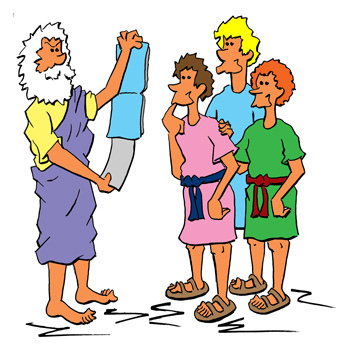
By Athenian Standards
But how much did the Clouds contribute to the prosecutions of Socrates? It is certainly possible that the Clouds made it hard for the Athenians to separate the stage Socrates from the real man much as today's motion picture and television depictions of historical characters confuse and mislead the viewers on what really happened. But Greek plays were not performed very frequently - only three or four days of the year and as part of religious festivals. But if the Clouds was the cause of the trial, it was a remarkably slow acting cause since it was first performed 30 years before the charges were brought. So we can conclude the play represented an already prevailing hostility to Socrates, but it's very questionable that it was the cause of Socrates being charged, tried, and convicted.
Returning to those thrilling days of yesteryear, after one question regarding William F." Buffalo Bill" Cody and the buffalo (actually the American bison), television presenter and barrister Clive Anderson said that replacing the buffalo in the American West with cattle caused the Dust Bowl. Actually cows themselves are no worse on grasslands than buffalo. Twenty million cows would not cause substantially greater problems on the ecosystem as twenty million buffalo. Sheep are the big grass killers.
We also have to consider the time factor. The famous Dust Bowl occurred during the 1930's, and this was half a century after the buffalo had been hunted to near extinction. Instead, the Dust Bowl, made famous by the songs of Woody Guthrie, was caused by a combination of exceptionally dry summers and poor farming practices which led to the wind erosion of the topsoil.
The dust storms that appeared in the 1930's actually pretty much disappeared in the 1940's. But there was a resurgence - although not on as grand a scale - in the 1950's. Nowadays, though, a true dust storm is fairly rare in the American West, and when they occur are featured on the national news.
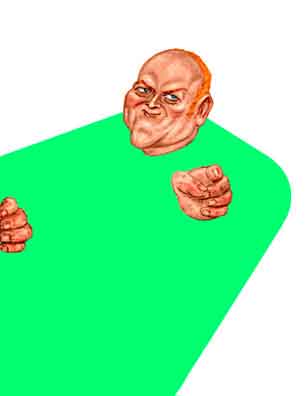
Dara O'Briain
The fans wouldn't let him get away with it.
Irish comedian Dara O'Briain once got a couple of points when he elaborated that zero degrees Celsius (or centigrade) was actually the triple point of water. He said he learned the fact in school and never thought he would have any use for it. Stephen congratulated Dara on his knowledge.
But the following year Dara was a guest again, and Stephen asked what was the triple point of water. Naturally Dara said zero degrees Celsius, and the flashing backgrounds and diving signal klaxons heralded the obvious but wrong answer. It seems, Stephen said, the triple point of water was zero degrees Celsius when Dara was in school. But in 1994 a new convention was adopted and the triple point of water was defined as "naught point naught one degrees", that is 0.01 deg Celsius. Dara's earlier answer, it seems, had prompted Britain's more knowledgeable viewers to write in, and Stephen felt he had to rectify the error.
Sadly, Dara's claiming that he was rounding off did not restore the lost points. He then said there must have been millions of viewers who saw his mistake and said "I know it's comedy show but we're not letting the fecker get away with that.
Actually the triple point of water has never been zero degrees Celsius. The original two point definition of the centigrade scale as defined by Anders Celsius himself - as Stephen actually stated - set the boiling point of water at 1 atmosphere as 0 degrees - yes, the boiling point was 0 degrees. The freezing point of water was 100 degrees. It was only the year that Anders died that scientists flipped the definition to our where zero was actually colder than 100.
But even with the zero=freezing and 100=boiling definition, the measured triple point of water was still 0.01 to the nearest hundredth of a degree. So Stephen was wrong when he said in Dara's school days zero degrees was the triple point of water.
What happened in 1994 was that both defining points of the Celsius scale were changed. The first - the lowest defined temperature - was switched to what it is now, that of absolute zero, the unobtainable temperature at which all molecular motion ceases. It was defined as exactly -273.15 degrees Celsius. The second - upper - defining point of the Celsius scale is indeed the triple point of water and is defined at the number Stephen gave - exactly 0.01 degrees.
So Stephen missed another chance to make the panelists fall into a trap. He could have asked them how the freezing and boiling points of water are currently defined on the Celsius scale. Everyone would have said 0 and 100 degrees respectively. Then the diving signals and flashing signs would have gone off, and Stephen would sadly have told them that with the new convention the freezing and boiling points of water are now measured values, not defined. According to the National Institute of Standards and Technology the freezing point of water is now 0.000089 degrees Celsius and the boiling point is 99.9839 degrees.
Another science - or at least technology question - was what did the frog have to do with - as Stephen put it - "one night stands"? After some bantering back and forth the answer was revealed as the frog - actually the African clawed frog - was used up until 1960 as a vehicle for a pregnancy test. You injected some of the woman's urine into the frog and if within 8-12 hours the frog would ovulate, then the pregnancy was confirmed. "And until the 1950's," Stephen concluded, "this was the only available pregnancy test."
Alas, the use of the African clawed frog was not the only available pregnancy test for the era. At least in the United States, the "rabbit test" was common, and "the rabbit died" was the euphemism for pregnancy (actually all of the animals were "sacrified" in the test). But it is true that the procedure of the rabbit test was similar to the frog test in that the urine was injected into the animal - which was usually a mouse, not a rabbit - and the ovaries were examined. Probably the more correct statement is that the test with the African clawed frog was the most commonly used test in England before the introduction of the in vitro diagnostic tests.
Another animal that caused some difficulty - at least regarding the questions - was the elephant. Although the statements Stephen made were correct as far as they went, they were not correct when taken in the context of what the panel actually did.
Stephen gave Alan, Jimmy Carr, Cal Wilson, and Jack Whitehall cards with the silhouette of an elephant and ask them to put some red stickers on the knees. Inevitably the panelists placed the stickers where the legs bend forward and did so on all four legs. The klaxons went off and Stephen sadly told them that elephants only have two knees. The knees on the front "legs" were actually elbows.
Now Stephen was correct that anatomically the front legs of the elephant - an other mammals as well - are actually arms. But the parts of the arms the panelist labeled were not the elbows. They labeled what is actually the wrist. Most quadrupeds actually walk on their ends of their fingers (and toes for the back legs). So for the front legs, the wrist is what people mistake for knees. The elephant's elbows are actually up high about even with where the legs cross the body.

There is one error that must be corrected. In talking about strangely named chemical compounds (which included the heterocyclic arsenic compound known as "arsole"), Doon Mackichan saw the name of penguinone which she pronounced as "penguin-oh-nee". Actually the "-one" indicates the compound is in the class of compounds known as ketones, and the ending "-one" is pronounced simply as "ohn" or "own". So the word is pronounced "penguin-ohn" or "penguin-own ".

Penguinone
(Pronounced "Penguin-OWN")
Finally, even Sandi - the new host starting with the letter "N" - has made an error. She was talking about the Land Run of 1889 in what became the state of Oklahoma. This was when the so-called "Unassigned Lands" were open for white settlement. The settlers lined up on the border of the region and at the signal of a fired pistol, they all high-tailed it to the allotment they wanted. Sandy said the settlers were called "Boomers because of the sound of the gun that gave them the signal.
Alas, again this isn't correct. The Boomers were the followers of David Payne who had been a major advocate of opening the lands - which really belonged to the Native Tribes - for the white settlers. The etymology of "Boomers" is unclear but has ben stated arising from the "booming" vocal advocacy of Payne and his followers. Whatever the origins, Boomers had been illegally settling the land a full ten years before the actual run and were continually being driven out by the US Army. "Sooners", on the other hand, were those who tried to jump the gun in 1889 and sneak in early. And "Boomer Sooner" is the name of the fight song of the University of Oklahoma. It hasn't been lost on many that both the words "Boomer" and "Sooner" adopted with such pride by residents of the state actually refer to criminals.
All in all though, we have to say that in contrasting the knowledge imparted compared to its minor errors, Qi proves there can be something worth watching on television. Even if you can't see the show in the - ah - "colonies".
So to end on a positive note, one of the most impressive true answers was when Stephen asked how the Cherokee Native Americans actually pronounced the word "Cherokee". No one actually knew the answer a priori, but Rory McGrath began musing that the English "cha" sound is difficult for many foreign speakers and they substitute "tsa". The sounds of "r" and "l" are notoriously interchangeable, and the sound of "k" can be voiced and come out as a hard "g". So, Rory said, depending on where you put the accent, a likely pronunciation would be "tsa-la-gi".
"Tsalagi", in fact, is exactly the native pronunciation of "Cherokee" in the language itself.
References
Although perhaps not exhaustive, here are sources for at least some of the corrections cited above.
The Life and Times of Pancho Villa, Friedrich Katz, Standford University Press (1998). This is the definitive biography of Pancho and relates no last words. Pancho was dead by the time anyone got to the bullet ridden car.
The Civil War - Strange and Fascinating Facts, Burke Davis. This gives a breakdown of casualties of the war (ranging from 618,000 to 700,000) plus the casualties in the major battles.
"William Playfair and His Graphical Inventions: An Excerpt From the Introduction to the Republication of His Atlas and Statistical Breviary", Iam Spence and Howard Wainer, The American Statistician August 1, 2005, 59(3): 224-229. William's book, Playfair's Commercial and Political Atlas and Statistical Breviary, is available from Cambridge University Press.
The Roman Emperors: A Biographical Guide to the Rulers of Imperial Rome 31 B.C.-A.D. 476, Michael Grant, Barnes and Noble, New York, (1997). Augustus is considered the first Roman Emperor by modern historians although the Romans themselves did not think in those terms. In the early empire, the historians like Suetonius wrote of the Caesars who in his time were members of the Julian Claudian family whose dynasty began with Julius. But the picture on the Qi screen was definitely Augustus, not Julius.
Leonardo Da Vinci: Flights Of The Mind, Charles Nicholl, Viking Press (2004). The most recent biography of Leonardo, very readable and written in an informal, perhaps even breezy style. But it mentions Leonardo's problems with the German workman.
Nero, Edward Champlin, Belknap Press (2003). Professor Ted Champlin is probably the foremost authority on Nero today and his book tells some quite interesting stories about this rather strange young emperor who (as Penn State's Garrett Fagan put it) soon found that there was no job description for the empire's top spot. An emperor could do pretty much as he pleased.
Not only were Nero's last words not "Qualis artifex pereo", but Professor Champlin makes put forward a (quite) interesting argument that indeed Nero did start the fire that burned Rome, a tradition most modern historians pooh-pooh. In one of the conspiracies against Nero, a tribune of the Praetorian court, Subrius Flavus, was found out and brought before the emperor. Nero asked Subrius why he conspired against his leader. According to Tacitus, Subrius replied, "I hated you, yet not a soldier was more loyal to you while you deserved to be loved. I began to hate you when you became the murderer of your mother and your wife, a charioteer, an actor, and an arsonist." The point Professor Champlin makes is that all historians agree the claims against Nero were correct, except for being an arsonist which mainstream historians tend to doubt. But Tacitus - one of the most careful of ancient Roman historians - said he was quoting the actual Latin of the soldier. So within months of the Great Fire, one of Nero's inner circle stated that Nero did indeed set the fire of Rome or ordered others to do so. For what it's worth, Tacitus himself doubted Nero actually started the fire.
"Lysergic acid amides of organic bases," Arthur Stoll and Albert Hofmann, US 2090430 (1937). Although the claims do not specifically cite it, they are broad enough to include the preparation of the infamous lysergic acid, diethylamide or LSD-25. So Albert's research on the ergot alkaloids began well before the founding, not only of the CIA, but it's predessor, the OSS - the Office of Strategic Services.
"The criminal and the saintly body: autopsy and dissection in Renaissance Italy, Renaissance Quarterly, Katharine Park, Vol. 47, No. 1, (1994). This article cites an autopsy performed on the abbess of Montefalco by the nuns into order to find indications of their leader's sainthood. In this case the heart of the deceased was found to contain a cross or the image of Christ. For the next two days, they kept chopping up the heart and found - so they said - "the crown of thorns, the whip and column, the rod and sponge, and tiny nails". The point of the story is that this dissection was in 1308 and the nuns quite literally gutted the dead abbess, and no one - not the fellow nuns, not the bishops or cardinals, and not even the Pope - saw anything amiss with it.
In fact, the first recorded autopsy in Italy was 1208. It was very common for physicians to carry out autopsies to try to determine the cause of death and anatomy professors at the various universities would hold demonstrations, sometimes in their own homes, but more often at the university. Dissection were never banned either in the Middle Ages or the Renaissance.
The Naked Man : A Study of the Male Body, Desmond Morris, Jonathan Cape, (2008). In this book, the well-known author of The Naked Ape discusses - among other things - the variations of the testiculos ceremony and points out that the story of Pope John/Joan is indeed fictitious.
Concise Dictionary of Middle Egyptian, Raymond O. Faulkner, Oxford University Press (1962). The word for cat is miw, which as we say, was almost certainly pronounced something like "mee-yew".
Notebooks, Leonardo Da Vinci, (Eds., Martin Kemp, Irma A. Richter), Oxford World Classics, Oxford University Press (2008). This edition has the story of the old man in the hospital.
The Man Who Stopped Time : Edweard Muybridge - Pioneer Photographer, Father of the Motion Picture, Murderer, Brian Clegg, Sutton Publishing Ltd. (2007). This book perhaps spends too many pages on when Eadweard was charged and tried for murder. Still it's a decent biography and does talk in some detail about the technical hurdles he had to overcome to get exposure times of his photographs down to 1/1000 of a second in a day when some photographers still took pictures by putting a hat on and off the lens.
"An Asteroidal Companion to the Earth", Paul A. Wiegert, Kimmo A. Innanen, and Seppo Mikkoloa, Nature, Vol. 387, pp. 685-686 (June 12, 1997). This paper points out Cruithne is an asteroid with an orbit in resonance with the earth. The diagram from the earth's perspective shows the orbit does not circle the earth as would a true moon.
Prisoner's Dilemma: John Von Neumann, Game Theory, and the Puzzle of the Bomb, William Poundstone, Doubleday (1992). This book covers game theory and has a section specifically about John Nash's equilibrium points and how testing showed real people actually avoid the predicted behavior. This is not unusual in game theory. The rational "best" solution is not what many people will choose. People, it seems, do yet not behave like algorithms.
Nelson A Personal History, Christopher Hibbert, Viking, Penguin, 1994. This mentions how Horatio's body was put in the brandy cask and strapped to the mainmast and put under guard. There was certainly no tapping of the admiral.
"Bier Barrel", http://www.snopes.com/horrors/cannibal/tapping.asp. If you want to check up on the Internet using the Internet, always go to Snopes. This particular article covers the "dead body in a barrel" legend and mentions the "tapping the admiral" version with Horatio Nelson as one of many variants of the legend.
The Trial of Socrates, Isidor F. Stone, Little Brown (1988). This is the most cited reference regarding the political reasons for Socrates' trial and discusses the enmity that Socrates aroused in the Athenians. However, I. F.'s claim that Socrates wanted to humiliate the Athenians by deliberately wanting to be executed is a little more debatable. At that late date in Socrates' life, he probably felt he had nothing much to loose.
The Clouds, Aristophanes (Translator: William Arrowsmith). New American Library (1962). A modern translation like this one captures the idiom better for English audiences compared to that of the more literal renderings. The Greek original is available in the widely available Loeb Classical Library series.
Although Plato himself seemed to downplay the negative picture of Socrates in the play (in one dialog he has Socrates saying he is "twitted" in the theater and has Aristophanes and Socrates conversing in a friendly manner), it's hard to believe the play does not reflect a true hostility toward the philosopher who at the time of the plays performance was only 44 year old. Many Athenians saw Socrates - to use the words of the University of Pennsylvania's Jeremy Mcinerney's - a smart aleck who wasn't a real philosopher and who attracted a bunch of lazy rich kid lagabouts. Then when one of those lazy lagabouts ended up as one of the Thirty Tyrants and started executing Athenian citizens, Socrates was seen as the root of this evil.
"Thomas Jefferson and Sally Hemings: A Brief Account", http://www.monticello.org/plantation/hemingscontro/hemings-jefferson_contro.html. This is an objective and reasoned account of the Tom/Sally relationship. Interestingly, Sally's youngest son, Eston, and his descendants were and still are accepted as ethnically white. Since the 1940's, the tradition in that part of the Hemings family was that they were descended from one of Thomas Jefferson's uncle, rather than Tom. However, the tradition of the descendants of Madison Hemings, an older son whose descendants are considered African American, is that Tom was Madison's father.
Big Integer Calculator, http://www.javascripter.net/math/calculators/100digitbigintcalculator.htm